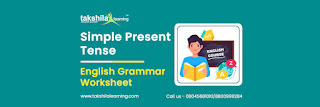Simple Present Tense Worksheet - English grammar
The simple present tense is a verb tense used to express current events, fixed routine operations, and occurrences.
Simple Present Tense Worksheet
Fill in the blanks with the correct verb form using the word given in the brackets.
- Sita _____________. (Draw)
- He __________. (Come)
- We ________ in your notebook. (Write)
- You ______ to the park every day. (Go)
- Sohan _________ me. (Remember)
- Raj _________ in the same park. (Play)
- Raju can ___________. (Dance)
- I ___________ everyday. (Read)
- Sita ____________ her Holi with mother every year. (Celebrate)
- Gita ___________ in front of the line in the morning. (Stand)
- They ________ everyday. (Play)
- She _______ every year. (Carve)
- Rita can not _______. (Walk)
- I ______ him. (Hit)
Click worksheet for Simple Present Tense examples and exercise
Click For more School worksheet
Tag- English grammar, Tense, English Worksheet, School online classes, Tense Worksheet

Comments
Post a Comment
Thank you we will contact ASAP.